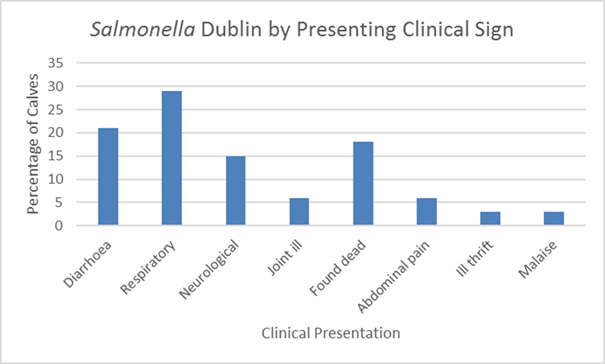Salmonella Dublin in beef herds
While Salmonella Dublin associated disease is more common in dairy herds than suckler herds, problems can still occur, particularly around calving time.
We have looked closely at our data for Scotland and thirteen percent of all Salmonella Dublin diagnoses are made in beef herds, and often cause clinical signs and mortality in both calves and adult cows.
A review of pre-weaning beef calf mortality in Scotland between 2016 and 2020 identified Salmonella Dublin as the third most common cause of mortality in pre-weaned calves in south-west Scotland (Dumfries and Galloway and Ayrshire), highlighting the impact of the bacteria in this region.
The presence of clinical Salmonella Dublin infection in the beef herd appears to correlate with the prevalence of Salmonella Dublin in the dairy herd, with 70% of diagnoses in beef cattle made in south-west Scotland, the area of highest clinical and serological prevalence in Scotland. However, in addition 15% of diagnoses were made in the north region of Scotland and 15% in the central and south-east Scotland, and so it should be considered as a differential in these areas as well.
The severity of the clinical disease in beef herds varies, and is thought to depend on stress factors and concurrent disease. It is of note that the peak of diagnoses in Scotland came in the spring of 2018 following the ‘beast from the east’ when many cattle were housed for longer and cattle were often reported to be in poorer condition than usual.
The bacterium can be identified as an incidental findings in some cases, while in the worst affected outbreaks, calf mortality reached 13% in addition to abortions and mortality in adult cattle.
The clinical signs identified in adult cattle were diarrhoea, pyrexia and abortion, while clinical signs in calves were more variable, and differed from those made in dairy calves. This is shown below, which highlights that diarrhoea was not the most common clinical presentation made in suckler calves.

Control and Management
Control of Salmonella Dublin is much less well evidenced in beef herds than in dairy herds and the ongoing close contact of cow and calf in the neonatal period can make control more challenging. Additionally, weather patterns are likely to have more of an impact on beef herds than dairy herds.
Cows around calving will increase their faecal shedding of Salmonella, due to a reduction in dry matter intake and volatile fatty acid production and periparturient dip in immunity.
This, combined with the fact that neonatal calves are most susceptible, means that control measures need to be focused around the periparturient period.
Factors to address would be:
- Cleanliness and bedding of calving environment
- Length of housing after calving
- Stocking density in housing and at grass
- Grazing history of fields used for calving
- Age spread of calves within groups
- Concurrent disease
- Nutrition and dry matter intake in late pregnancy and around calving
- Biosecurity and purchasing decisions, particularly when purchasing from dairy herds
Depending on the spread of calving, vaccination may prove useful during an outbreak for later calving cows, although there will be a delay for administration of the primary course and onset of immunity. For herds with tight calving patterns, it may be something to consider for the following calving season.
Posted by SRUC Veterinary Services on 27/01/2023
